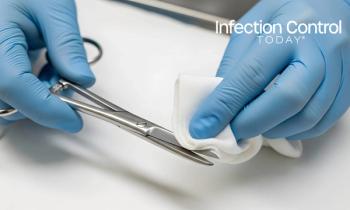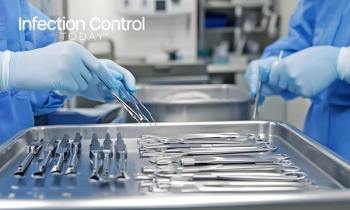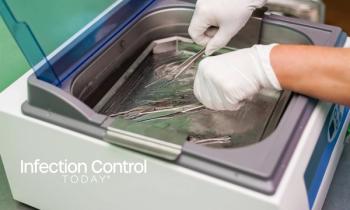
Best Practices to Keep Your Surgical Instruments Moist
There is nothing more challenging to effective cleaning than receiving instruments in the decontamination area that have dried blood on them. Reducing this concern has always been an issue.
By Matt Smith
There is nothing more challenging to effective cleaning than receiving instruments in the decontamination area that have dried blood on them. Reducing this concern has always been an issue.
Â
Although it is recognized that contaminated surgical instruments should be cleaned immediately after use, it is observed that this is not always practical. However, dried blood does represent a great challenge to the cleaning of patient-used instruments (AAMI ST 79:2010 7.5.2). Many professional groups recommend that the processing of instruments take place within 30 minutes after the instruments are used in surgery to prevent organic soils from drying. Often device manufacturers instructions also recommend decontamination begin as soon as possible, not just to prevent drying of organics, but also to limit the chance for damage to the instrument.
Â
Keeping instruments or equipment moist is only one of the issues. The other major issue is to safely transport the contaminated sharps. Both the 3rd edition of "The Basics of Sterile Processing" by Sterile Processing University and the "IAHCSMM 7th Edition Central Service Technical Manual" stress that items being transported in a covered, puncture-proof container that is clearly marked with a biohazard label according to OSHA guidelines.
So the issues are safely transporting instruments that are moist and processing them as quickly as possible after use. If you cannot quickly process the items at point of use, you must mark them as a biohazard and try to keep them as moist as possible until they can be properly decontaminated.
How long can an instrument wait after its final surgical use before the cleaning process begins? This wait period could be called decontamination holding time (DHT). The user of the instrument plays a key role in the condition of the instrument based upon how the instrument is sent back (i.e., gross soil still present). Failure to properly prep instruments (i.e., wiping off excess soil with a lint-free towel; taking measures to keep instruments moist during transport) will add time to the process. The fact that DHT could be minutes to hours and even days in some cases is a concern.
Transporting and keeping instruments moist after use so they can be more easily cleaned involves four factors:
1. Where are instruments used and how are they taken care of at the site of use during and after usage
2. How the instruments are transported to the decontamination area for cleaning in a manor that protects all staff
3. The length of decontamination holding time
4. How the instruments are kept moist
Perkins states in his book, "The Principles and Methods of Sterilization in Health Science" (page 237), "...Instruments must be cleaned as soon as possible after use, to avoid rusting or pitting, and to remove soil before it can dry and harden in the serrations and crevices. If stainless steel instruments are permitted to lie around for several hours before cleaning they may acquire a tarnish, which is difficult to removetherefore, immediately after use the instruments should be rinsed in cold water." Staff should not use saline to keep instruments moist because saline can damage instruments. When in doubt about how to keep instruments moist, refer to the instructions for use (IFU) supplied by the manufacturer of the instruments.
There are three common ways to keep instruments moist:
1. Wet towel
2. Spray-on detergent
3. Self-seal pouch with absorbent layer
The placing of a wet cloth over instruments after surgery has been the traditional method of keeping instruments moist. It can be quite effective for relatively short periods of time (say, up to an hour).
Spray-on solutions are typically enzyme or some other protolytic formulations designed to break down blood soil and protein, as well as delay drying of organic soils. These solutions will keep instruments moist longer than the traditional wet towel method, providing moisture for a couple of hours. For the exact recommended duration, check with the solution manufacturer's IFUs. Some facilities have their OR staff spray the instruments before they leave the department for the sterile processing area.
Self-seal pouches with an absorbent layer are manufactured from a low-linting, highly absorbent material sandwiched between two layers of a transparent film. The transparent layers enable observation of the materials kept in the pouch. A specified amount of water is added to the absorbent material and soiled instruments are kept in the pouch, which is then sealed. This creates a humid environment where the instruments remain in a moist state until taken for cleaning. These devices are the optimal choice if an extended time (two or more hours) is needed before instruments can be reprocessed. Studies have demonstrated that instruments in these type of devices will remain moist for up to three days. Of course, the sooner decontamination begins the better and extended storage in a moist environment may not be well tolerated by some instruments. Be sure to consult with the device manufacturer.
Lisa Redfern, central sterile supply manager at Medical Center Hospital, implemented the use of self-seal pouches with an absorbent layer in her department. By the time surgical instruments were getting to my department, the blood substance would be dry making them more difficult to clean. These specially designed pouches provided more time in order to keep the instruments moist and therefore easier to clean. It has worked out well for us, even other departments in the hospital are starting to use them.Â
Â
All institutions are unique and follow different processes. For some medical facilities, decontamination holding time may not be an issue. For others, because of the number of surgeries and staffing issues, a longer time frame to begin the cleaning of surgical instruments is a common occurrence. When evaluating your facilitys process, you may want to consider some of the options described in this article to improve the cleaning of surgical instruments.
Matt Smith is marketing analyst for Healthmark Industries Co.
Â
Â
Newsletter
Stay prepared and protected with Infection Control Today's newsletter, delivering essential updates, best practices, and expert insights for infection preventionists.






